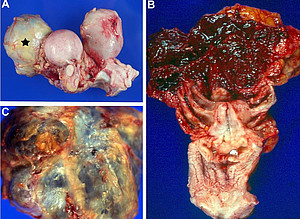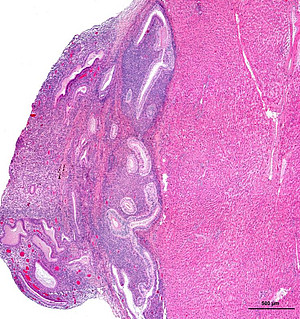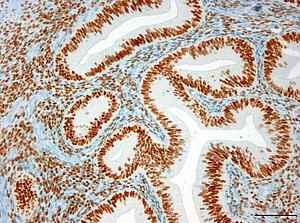Spontaneous Endometriosis
Endometriosis is defined as the presence of uterine mucosa outside the uterine cavity and is one of the most common causes for chronic abdominal pain and infertility in women. It also occurs in many menstruating non-human primate species, such as rhesus monkeys (Macaca mulatta), cynomolgus monkeys (Macaca fascicularis) or baboons (Papio sp.). The disease is often difficult to diagnose at early stages and can severely impair the patient’s health and well-being. Although known for more than 300 years, the cause and pathogenetic mechanisms of endometriosis remain unclear. There are different explanatory approaches, like the theories of transplantation, metaplasia or induction, where parts of the uterine mucosa reach the abdominal cavity during menstrual bleeding or via surgical procedures, and either direct implantation and/or transformation of peritoneal cells into mucosal tissue takes place. Those mucosal plaques can grow and spread further by hormonal stimulation so that many pelvic and abdominal organs are involved frequently. Besides that, genetic and immunologic factors as well as certain pollutants (PCB, DDT, Dioxine) seem to play an important role in disease development.
In the breeding colonies of the DPZ, cases of spontaneous, not experimentally induced endometriosis occur in female rhesus and cynomolgus monkeys with an incidence of approximately 6%. This provides an excellent opportunity for investigating this disease in its ‘natural’ form in order to gain important insights into both, clinical symptoms and early diagnosis as well as promising treatment options and possible pathogenetic mechanisms. Hence, a comprehensive retrospective study on necropsy material from nine rhesus macaques with spontaneous endometriosis revealed familial clustering of occurrence in first grade relatives while clinical symptoms and macroscopical changes appeared to be highly variable. Additional histological and immunohistochemical examination showed clear evidence that rather poorly differentiated forms of endometriosis exhibit similar characteristics like peritoneal tissue so that they most probably represent early immature lesions that further develop into well-differentiated mature mucosal tissue over time, supporting the theory of metaplasia as the main pathogenetic mechanism.
Relevant literature:



